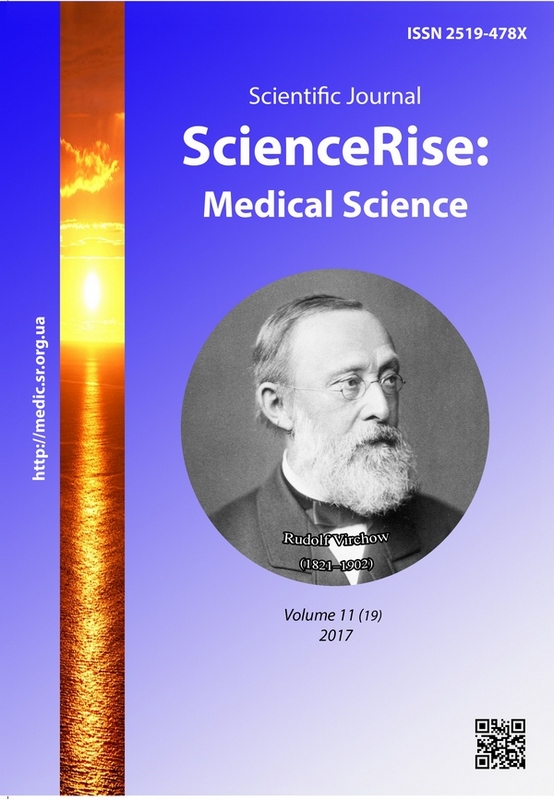Intraocular pressure investigation during lumbar spine surgery in prone position
DOI:
https://doi.org/10.15587/2519-4798.2017.116416Keywords:
prone position, intraocular pressure, general anesthesia, spinal anesthesiaAbstract
Aim: to estimate intraocular pressure changes at lumbar spine surgery in prone position at the general intravenous anesthesia and at the spinal anesthesia and to compare these data with healthy volunteers.
Materials and methods. The research included 10 healthy volunteers and 40 patients ASA І-ІІ, who underwent planned surgical interventions on the lumbar spine in prone position. Patients of І group (n=20, men 7,women 13, mean age 47±14 years) underwent surgical interventions under conditions of the spinal anesthesia. Patients of ІІ group (n=20, men 8, women 12, mean age 44±12 years) underwent surgical interventions under conditions of the general intravenous anesthesia. Patients’ prone position was horizontal in both groups. The head turned at the angle 45° (the left eye lower than the right one). The intraocular pressure was estimated by Maklakov’s method by one researcher in the position on the spine before surgery and immediately after it. Healthy volunteers (n=10, menв 4, women 6, mean age 49±12 years) were examined in the position on the spine, after that they lied in the analogous prone position during 90 minutes and were examined immediately after turning on the spine.
Research results: patients of both groups and healthy volunteers demonstrated the increase of the intraocular pressure after lying in prone position (р<0,001), moreover it was higher in the left eye (the lower one). In patients of 2 group (general anesthesia) IOP increase in the low eye was reliably (р=0,03) more than in patients of I group and healthy volunteers. Patients of I group didn’t demonstrated reliable changes compared with the group of healthy volunteers.
Conclusions: at turning in prone position healthy volunteers and patients under anesthesia (spinal, general) demonstrate the intraocular pressure increase. IOP increases in patients under the general anesthesia were reliably higher in the lower eye, than in patients of the group of the spinal anesthesia and healthy volunteers
References
- Epstein, N. (2016). How to avoid perioperative visual loss following prone spinal surgery. Surgical Neurology International, 7 (14), 328–330. doi: 10.4103/2152-7806.182543
- Nickels, T., Manlapaz, M., Farag, E. (2014). Perioperative visual loss after spine surgery. World Journal of Orthopedics, 5 (2), 100–106. doi: 10.5312/wjo.v5.i2.100
- Kamel, I., Barnette, R. (2014). Positioning patients for spine surgery: Avoiding uncommon position-related complications. World Journal of Orthopedics, 5 (4), 425–443. doi: 10.5312/wjo.v5.i4.425
- Mason DePasse, J., Palumbo, M., Haque, M. et. al. (2015). Complications associated with prone positioning in elective spinal surgery. World Journal of Orthopedics, 6 (3), 351–359. doi: 10.5312/wjo.v6.i3.351
- Attari, M., Mirhosseini, S., Honarmand, A., Safavic, M. (2011). Spinal anesthesia versus general anesthesia for elective lumbar spine surgery: A randomized clinical trial. Journal of Research in Medical Sciences, 16 (4), 524–529.
- Lyzogub, M. (2014). Spinal anesthesia for lumbar spine surgery in prone position: plain vs heavy bupivacaine. European Journal of Anaesthesiology, 31, 133. doi: 10.1097/00003643-201406001-00373
- Lee, L. A. (2013). Perioperative visual loss and anesthetic management. Current Opinion in Anaesthesiology, 26 (3), 375–381. doi: 10.1097/aco.0b013e328360dcd9
- Jangra, K., Grover, V. (2012). Perioperative vision loss: A complication to watch out. Journal of Anaesthesiology Clinical Pharmacology, 28 (1), 11–16. doi: 10.4103/0970-9185.92427
- Hayreh, S. (1997). Anterior ischemic optic neuropathy. Journal of Clinical Neuroscience, 4 (5), 251–263.
- Pillunat, L. E., Anderson, D. R., Knighton, R. W., Joos, K. M., Feuer, W. J. (1997). Autoregulation of Human Optic Nerve Head Circulation in Response to Increased Intraocular Pressure. Experimental Eye Research, 64 (5), 737–744. doi: 10.1006/exer.1996.0263
- Malihi, M., Sit, A. J. (2012). Effect of Head and Body Position on Intraocular Pressure. Ophthalmology, 119 (5), 987–991. doi: 10.1016/j.ophtha.2011.11.024
- Lee, T.-E., Yoo, C., Kim, Y. Y. (2013). Effects of Different Sleeping Postures on Intraocular Pressure and Ocular Perfusion Pressure in Healthy Young Subjects. Ophthalmology, 120 (8), 1565–1570. doi: 10.1016/j.ophtha.2013.01.011
- Lam, A. K. C., Douthwaite, W. A. (1997). Does the Change of Anterior Chamber Depth or/and Episcleral Venous Pressure Cause Intraocular Pressure Change in Postural Variation? Optometry and Vision Science, 74 (8), 664–667. doi: 10.1097/00006324-199708000-00028
- Murphy, D. F. (1985). Anesthesia and Intraocular Pressure. Anesthesia & Analgesia, 64 (5), 520–530. doi: 10.1213/00000539-198505000-00013
- Deniz, M. N., Erakgun, A., Sertoz, N., Yilmaz, S. G., Ates, H., Erhan, E. (2013). The Effect of Head Rotation on Intraocular Pressure in Prone Position: a Randomized Trial. Brazilian Journal of Anesthesiology, 63 (2), 209–212. doi: 10.1016/j.bjane.2012.03.008
- Hvidberg, A., Kessing, S. V., Fernandes, A. (1981). Effect of changes in PC02 and body positions on intraocular pressure during general anaesthesia. Acta Ophthalmologica, 59 (4), 465–475. doi: 10.1111/j.1755-3768.1981.tb08331.x
Downloads
Published
How to Cite
Issue
Section
License
Copyright (c) 2017 Mykola Lyzohub

This work is licensed under a Creative Commons Attribution 4.0 International License.
Our journal abides by the Creative Commons CC BY copyright rights and permissions for open access journals.
Authors, who are published in this journal, agree to the following conditions:
1. The authors reserve the right to authorship of the work and pass the first publication right of this work to the journal under the terms of a Creative Commons CC BY, which allows others to freely distribute the published research with the obligatory reference to the authors of the original work and the first publication of the work in this journal.
2. The authors have the right to conclude separate supplement agreements that relate to non-exclusive work distribution in the form in which it has been published by the journal (for example, to upload the work to the online storage of the journal or publish it as part of a monograph), provided that the reference to the first publication of the work in this journal is included.









